If you're installing a remote start system you should
consider adding some
additional interlocks to make sure the car can't start unless it's safe to do
so.
Here's what I did for my Remote Start system
Background
Most remote-start systems are designed for use on automatic transmissions because they have inherent safeties - the car won't start unless the transmission is in Park. This means not only is the transmission in a "neutral" gear but the "park lock" is engaged which keeps the car from moving. On a manual transmission car the starter won't engage unless the clutch pedal is depressed, so in order to use remote start you have to bypass the clutch safety switch. Now the car can be remote-started, whether it's in neutral or not.
Some high-end alarm/remote-start systems use a combination of "procedural interlocks" to more or less limit the conditions under which the car can start. For example, some systems require the clutch pedal be released while the engine is running, just prior to shutdown. The idea is that if the clutch pedal is out and the engine is running the transmission must be in neutral, so the system allows remote start anytime before the next normal start cycle. This is better than nothing but does not guarantee the transmission isn't shifted after the car is shut down.
My remote start system was designed for an automatic transmission only, so to guarantee remote start would be as safe as I could make it I added these interlocks:
| Parking Brake switch - the brake must be fully engaged to do a remote start. | |
| Neutral switch - the shifter must be in neutral to do a remote start | |
| Speedometer signal shutdown - if a speed pulse is sensed the engine shuts down |
Here's a video (12MB QuickTime) of the brake & neutral interlocks in action. Pay attention to the blue LED mounted on the console between the roof switch and hazard switch. The LED lights when remote start is enabled, meaning both the parking brake and shifter are correctly set up. If the LED goes out, remote start cannot occur, or will shut down if it's already running. Note that there is enough "slop" in the neutral switch so the normal jiggling of the lever when the engine starts does not cause it to go "open" and stop the engine.
Parking Brake Switch - You might think you could use the factory brake switch to do this function but the problem is that it was designed to sense when the brake was fully OFF. Pulling the brake up a single click will activate the factory brake switch but you have no effective brake action till the lever is moved at least 5 or 6 clicks. So I added a second switch to the parking brake, one that would only activate if the brake was fully applied.
| Here's a photo of the parking
brake assembly under the center console. Ignore the red stereo cables
but pay attention to the gold-colored rod that is just above them.
This is the brake rod, and when the parking brake is applied the rod is
pulled towards the front of the car. I clamped a piece of sheet metal to the rod using a 6-32 screw and nut to squeeze the metal strip tight. This allows it to be adjusted anywhere on the rod, and the screw is long enough to stick out the back side about 1/2". The extended screw is to activate a micro-switch when the brake is applied. |
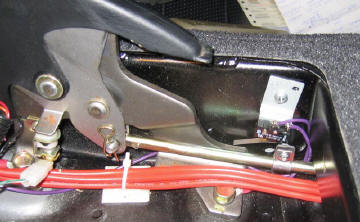 |
| Here's a close-up showing the
micro-switch mounted on a small right-angle bracket and screwed into the
side of the center tunnel. The switch is positioned so the when the
brake rod moves forward the screw on the "rod clamp" hits the switch lever
and closes the switch. By sliding the rod clamp back and forth I can easily adjust it so the switch won't close until the brake is fully applied - about 8 or 9 clicks in my case. Here's a link to a Radio Shack switch that looks like it would work, but you'll have to fabricate your own mounting bracket. The switch contacts are wired to a into the remote start system so when the switch is open (brake OFF) the system sees a "hood open" signal, which both prevents remote start and shuts down the engine if the brake is released during a remote-start session.* |
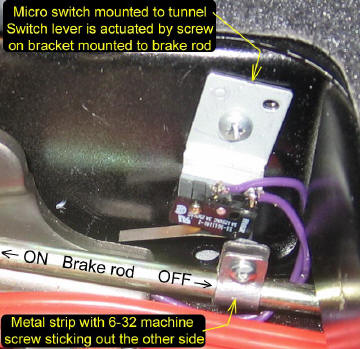 |
Neutral Switch - This was much harder to build and adjust till it worked just right. There isn't much room in the shifter boot area and the shift lever doesn't move very far between gears. That's great for driving but not for building a neutral detector system. I ended up mounting a small magnet to the shifter and using it to activate a reed switch mounted to the side of the tunnel. I'll start by showing you the finished product then details of construction.
| Here's a tight shot
of the shift lever showing the bracket I attached to it, the little magnet
(gold dot) on the end of it, and the reed switch assembly. Reed switches are small, low-current switches made by inserting two strips of magnetic material into a glass tube. The ends of the strips are set just barely apart in the center of the glass tube so the electrical circuit between them is normally open. When a magnet is brought close enough the magnetic field is absorbed by the strips, they attract to each other, bend and touch, thereby closing the circuit. Radio Shack no longer carries reed switches but if you look on ebay you'll find plenty. They're cheap because they are "old technology", but be warned - they are extremely fragile. You can crack the glass envelope if you bend the wire leads by hand. Always hold the lead close to the glass body with a pair of needle-nose pliers when bending the leads. |
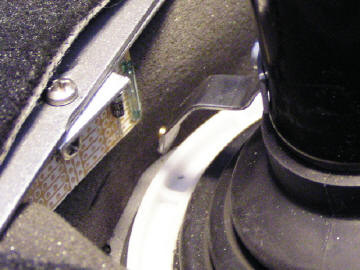 |
| Here's a photo of
the reed switch board I build. I added a diode across the switch
contacts to protect the switch from back-EMF. Might not be absolutely
required but it was easy enough to do and guarantees the switch will survive
when it's used to switch the starter relay. If you click on the photo you will get an enlarged version and you can actually see the gold-colored metal "reeds" inside the glass tube. I slotted the board to allow for some adjustment and the top mounting screw also pivots. Between these two I was able to position the reed so it was close to the magnet when the shifter was in neutral. The reed switch is connected to the clutch interlock switch so that when the shifter is in neutral the reed switch closes, the interlock is bypassed, and the engine will crank. This has an added benefit - I can start the car manually without depressing the clutch if the shifter is in neutral. I do this often when working on the car and don't feel like getting inside to crank it up. |
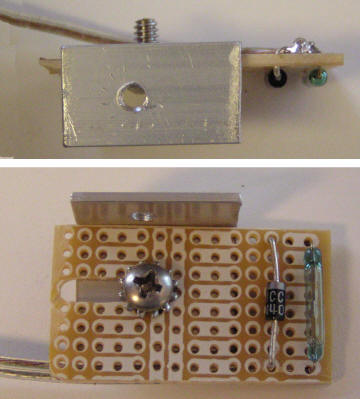 |
| Close-up of the
magnet bracket mounted to the side of the shift lever. The bracket is
bent so the magnet is down at the bottom of the rubber boot. This is
necessary because the vinyl shift boot (in the console) falls down into this
cavity and I didn't want it interfering with the switch assembly. The magnet is a NIB disk purchased from an Internet store like this one. NIB magnets (nedymium-iron-boron) are extremely strong magnets, but you could use a regular magnet if it was larger and adjusted properly. I glued it to the bracket with super-glue. Speaking of adjustment, since the magnet on my bracket only presents one pole to the reed switch, I needed to align it with the END of the glass tube, not the middle. The idea is to create opposite magnetic fields in the 2 reeds (so they attract) so if I only have a North pole facing the reed and put it in the center of the tube, both reeds would see the same magnetic field, and no attraction would take place. |
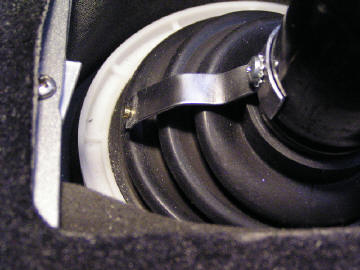 |
| And now a photo of
the magnet bracket. The top is curved to hug the shifter lever with a
single hole for mounting. I drilled and tapped the shift lever for a
6-32 machine screw which holds nicely. As you can see the bracket is bent to clear the rubber boot and position it near the reed switch. You will have to do some experimenting with your bracket because you will undoubtedly mount it and the reed switch a little different than I did, but this should give you a starting point. |
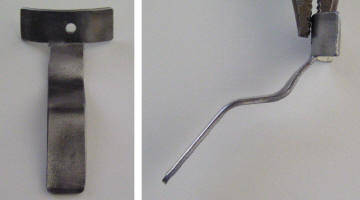 |
Speedometer signal shut down - This feature is something most of you won't be able to build and it's overkill anyway I only added it because I could. It required some electronics to sense a single speed pulse and electronically activate the brake pedal switch. Remote start systems will shut down if the brake pedal is depressed, so I used that feature to shut off the engine if the car moves. Since the speed signals occur every inch or so the car won't move very far before shutting down. Of course that's only if the parking brake switch fails, since the car won't move at all with the brake on, and releasing the brake kills the engine too.